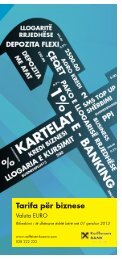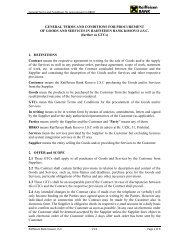Annual Report 2012 - Raiffeisen Bank Kosovo JSC
Annual Report 2012 - Raiffeisen Bank Kosovo JSC
Annual Report 2012 - Raiffeisen Bank Kosovo JSC
Create successful ePaper yourself
Turn your PDF publications into a flip-book with our unique Google optimized e-Paper software.
66<br />
<strong>Raiffeisen</strong> Glossary<br />
Gable Cross<br />
<br />
Group in CEE. It represents two stylized horse’s heads, crossed and attached to the gable of a house. It is a symbol<br />
of protection rooted in old European folk tradition: a gable cross on the roof was believed to protect the house and its<br />
occupants from outside dangers and to ward off evil. It symbolizes the protection and security that the members of the<br />
<strong>Raiffeisen</strong> banks enjoy through their self-determined collaboration. Today, the gable cross is one of Austria’s best-known<br />
trademarks and a well-recognized brand in CEE.<br />
<strong>Raiffeisen</strong> <strong>Bank</strong> International<br />
<strong>Raiffeisen</strong> <strong>Bank</strong> International AG (RBI) regards Central and Eastern Europe (CEE), including Austria, as its home market.<br />
In CEE, RBI operates as a universal bank through a closely knit network of subsidiary banks, leasing companies and<br />
numerous specialized financial service providers in 17 markets. At the end of <strong>2012</strong> around 60,000 staff served<br />
approximately 14.2 million customers in around 3,100 business outlets in CEE. In Austria, RBI is one of the top corporate<br />
and investment banks. Moreover, RBI is represented in the world's financial centres and operates branches and<br />
representative offices in Asia. All in all, RBI employs about 60,000 staff and has total assets of approximately € 136<br />
billion.<br />
RBI has been listed on the Vienna stock exchange since 25 April 2005 (until 12 October 2010 as <strong>Raiffeisen</strong><br />
<br />
<br />
of RBI's shares are in free float. With its long-term "A" (S&P, Fitch) and "A2" (Moody's) ratings, RBI is also a regular issuer<br />
of debt securities.<br />
RZB<br />
<br />
<br />
Austrian <strong>Raiffeisen</strong> <strong>Bank</strong>ing Group and RBI, with its banking network in Central and Eastern Europe (CEE) and numerous<br />
other international operations.<br />
RZB Group<br />
<br />
<strong>Raiffeisen</strong> <strong>Bank</strong>ing Group<br />
The <strong>Raiffeisen</strong> <strong>Bank</strong>ing Group (RBG) is Austria's largest banking group by total assets. As per year-end 2011, RBG's<br />
consolidated balance-sheet total amounted to more than € 269.6 billion. It represents about a quarter of all banking<br />
business in Austria and comprises the country's largest banking network with more than 2,200 business outlets and<br />
25,000 employees. RBG consists of <strong>Raiffeisen</strong> <strong>Bank</strong>s on the local level, Regional <strong>Raiffeisen</strong> <strong>Bank</strong>s on the provincial<br />
<br />
<strong>Raiffeisen</strong> <strong>Bank</strong>s are private cooperative credit institutions, operating as general service retail banks. Each province's<br />
<strong>Raiffeisen</strong> <strong>Bank</strong>s are owners of the respective Regional <strong>Raiffeisen</strong> <strong>Bank</strong>, which in their entirety own approximately 90 per<br />
<br />
The <strong>Raiffeisen</strong> <strong>Bank</strong>s go back to an initiative of the German social reformer Friedrich Wilhelm <strong>Raiffeisen</strong> (1818 – 1888),<br />
who, by founding the first cooperative banking association in 1862, has laid the cornerstone of the global organization<br />
of <strong>Raiffeisen</strong> cooperative societies. Only 10 years after the foundation of the first Austrian <strong>Raiffeisen</strong> banking cooperative<br />
in 1886, already 600 savings and loan banks were operating according to the <strong>Raiffeisen</strong> system throughout the country.<br />
According to <strong>Raiffeisen</strong>'s fundamental principle of self-help, the promotion of their members' interests is a key objective of<br />
their business policies.

















